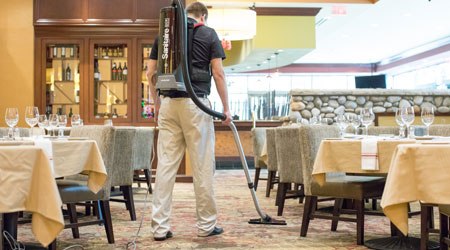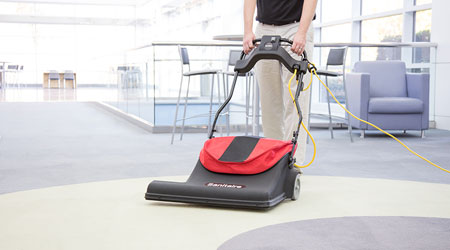
Productivity equals profitability in the commercial cleaning industry. In fact, industry expert Mickey Crowe recently estimated in Cleanlink that costs associated with labor and benefits can account for up to 90 percent of the costs of a cleaning contract. With so much cost tied up in personnel, productivity is a key to building business success. One task that can create serious impact when looking for more productivity: vacuuming.
Time spent vacuuming can account for a significant portion of total cleaning costs for any facility. Taking into account the space, type of work needed and how often cleaning occurs, vacuuming can represent from 15 to 25 percent of total cleaning costs, according to a Commercial Vacuum Cleaner Time and Motion Study from the American Institute for Cleaning Sciences (AICS). AICS data also shows that between one and three hours per day is spent vacuuming by commercial cleaning staffs.
With an array of commercial vacuums on the market, selecting the proper equipment for the job plays an increasingly important role in determining whether a cleaning business can become successful. There are several vacuum features that will naturally bring more efficiency to the workplace:
Maneuverability: The weight and portability of equipment play key roles in minimizing worker fatigue, helping to reach tough areas, increasing speed and safety and maximizing the productivity of cleaning crews.
Ergonomic Design: A design with a focus on comfort for the worker can help him or her operate with less physical stress and with higher efficiency. Musculoskeletal strain is reduced, which can even potentially lead to fewer lost workdays – another big step to increase productivity.
Durability: Vacuums that can withstand the daily wear and tear of a commercial environment are essential. Machines that last will reduce downtime, decrease the amount of equipment you need to buy and replace and, in turn, cut the cost of owning the equipment.
Ease of Maintenance: In addition, vacuums that allow quick, on-the-go maintenance with easy filter changes or belt replacements will mean less overall downtime. Reduced interruptions mean the cleaning can continue as seamlessly as possible.
With those features in mind, what type of vacuum should be chosen for ideal productivity? Much depends on the industry and specific demands of the job(s), such as vacuuming large conference rooms, maintaining clean carpets in hospital waiting areas, quick touch-ups before dinner service at restaurants or nightly cleaning in cramped office spaces.
There are three main types of commercial vacuums recommended for increased productivity: cordless uprights, backpacks and wide area vacuums. All three include many of the features mentioned above, based on their purpose and the jobs they're used for. Each is a cornerstone of vacuuming efficiency, if it fits your needs.
Overall, it's important to ensure that time spent vacuuming is as productive as possible. If fewer hours are spent vacuuming, overall efficiency – and profitability – will improve. Continue reading for in-depth breakdowns of the three vacuums recommended to accomplish this goal.
CORDLESS UPRIGHT VACUUMS:
Cordless vacuums increase productivity for a number of key reasons. Without having to deal with bothersome cords, cleaning crews can focus on efficient and powerful cleaning. Using corded models can also increase vacuum times due to outlet restraints. Each time a crew member has to find a new outlet, it costs time – and money – and may cause frustration for the worker, especially when cleaning areas have many furnishings or corners to maneuver around.
In fact, the AICS Commercial Vacuum Cleaner Time and Motion Study determined that commercial cleaning crews achieved 20 percent more vacuum coverage in an hour with cordless vacuums versus corded models.
The study, which focused on vacuuming in obstructed and unobstructed areas in office buildings, showed that "power cord management, outlet discovery and untangling the cord from door jams and partitions can consume additional time and worker effort." The study also found that asset damage in buildings could be caused by power cords, which require replacement as they become cut or worn – causing an additional decrease in productivity as a result of using corded vacuums. Vacuums with a reduced handle weight and easy maneuverability were also preferred by workers in the study.
Along with keeping employees happy and productive, safety is also increased when using cordless vacuums, as vacuum cords are a common cause of staff trips and falls. The hazard can be minimized with cordless vacuums with long-lasting battery life.
Whether it's down long hallways, in elevators or on stairs, cordless models provide the freedom for workers to clean uninhibited by constant cord management. By removing the need to plug in and move cords, cordless vacuums allow crews to clean more space in less time.
Beyond ease of use and efficiency, using a corded vacuum can be very impractical for a number of cleaning jobs – especially quick touch-up areas such as valet stands or movie theater lobbies. A last-minute mess is no problem with the lightweight, untethered and fast performance of a quality cordless vacuum, giving crews the power to jump right on it. Along those lines, hotels, bars and restaurants, which are constantly under public scrutiny and judged by their standard of clean, demand this type of quick, round-the-clock cleaning. It's crucial to have that ability in order to leave every guest impressed.
Important features to look for when choosing a cordless upright include a large-capacity battery with an extended run time and an efficient and low charging time for thorough, powerful cleaning where and when it's needed. The product should have a lightweight structure and be designed for multi-surface cleaning.
For cleaning professionals looking to increase productivity with a cordless vacuum, the new Sanitaire® QUICKBOOST™ cordless upright operates at less than 70 DBA for 24/7 Leadership in Energy and Environmental Design (LEED)-qualified cleaning and provides Carpet and Rug Institute (CRI)-rated cleaning performance.
BACKPACK VACUUMS:
When vacuum jobs are demanding and crews are required to provide a thorough, quick clean while also dealing with cluttered spaces with nooks, crannies, desks, multi-level surfaces and more, a versatile backpack vacuum may be just what is needed.
As the name implies, backpack vacuums are tank-style vacuums worn on operators' backs. They offer first-rate efficiency as well as features and design qualities that make them a great choice for cleaning professionals for facilities across multiple industries. They are portable and maneuverable and engineered for comfortable and fast cleaning; in tests, such as those from the AICS Commercial Vacuum Cleaner Time and Motion Study, backpack vacuums consistently cleaned faster than upright vacuums, especially in obstructed areas.
Backpack vacuums are built to help reduce strain on workers who clean floors, stairs, draperies and other above-the-floor surfaces. For professional cleaners, physical responsibilities can be demanding. It's crucial to help them avoid fatigue and injuries, most importantly for their health and wellbeing. But fatigue and injuries are also serious enemies of productivity.
Fortunately, creating a safe working environment can directly lead to increased efficiency by focusing on using ergonomically designed products – and it's hard to match the backpack vacuum in this regard. The stress of using a less ergonomic vacuum style, while maneuvering and cleaning in small spaces, can be greatly reduced with a backpack.
Backpack vacuums' many ergonomic aspects include the ability for a worker to maintain balance, as the vacuum's weight is distributed evenly across his or her body, making the equipment easier to lift and operate. Look for backpack vacuums designed with metals like magnesium and new plastic compounds, which maintain durability while reducing weight.
Backpack vacuums are also easy to maintain due to the absence of belts and brushrolls, saving even more time. While it's important to keep in mind that an upright vacuum may have greater deep cleaning power than a backpack model because of the beater bar, backpack vacuums are extremely versatile and maneuverable, often with numerous specialty features to efficiently handle jobs other vacuum types can't. The handheld wand on backpack vacuums is often equipped with tools for cleaning overhead vents, blinds and furniture, to name a few. These include telescopic metal wands, hard surface tools, upholstery tools, dusting brushes, crevice tools and more.
When choosing a backpack vacuum, look for a large-capacity bag for reduced workflow stoppage and a 50-foot pigtail cord for wide-range cleaning, quick changes and easy replacement. Also make sure it includes a variety of tools for carpet, bare floor, upholstery, stairs and more. A good example for increased productivity and ergonomic benefits is the versatile Sanitaire® TRANSPORT™ QuietClean® backpack vacuum. It has a lightweight design at under 12 pounds and a comfortable harness, allowing for effortless efficiency. Crews can even clean quietly and efficiently during the day with the 63 dBA TRANSPORT, helping businesses keep energy costs down and maintain their LEED certifications.
WIDE AREA VACUUMS:
For facilities with expansive carpeted areas, vacuuming efficiently can be a daunting task due to the sheer size and need for consistent cleaning. Conference rooms, convention centers and the like need to be vacuumed meticulously, and using the wrong type of vacuum for the job can cause major issues in overall productivity. These situations call for a vacuum that offers a smart solution, saving time and money.
One of the best ways to cover more ground in less time is to use wide area vacuums. The broad paths cleaned by these innovative machines can lead to major increases in efficiency, especially when compared to a standard vacuum or broom. They are designed to be easy and comfortable to use – with walk-behind design and ergonomic handles – without losing effectiveness. Look for models with numerous height setting options and easy-to-change yet rugged brushrolls to pick up debris that would clog most ordinary vacuums.

Crews looking to quickly clean large carpeted spaces should opt for a wide-area vacuum with a 28-inch-wide cleaning path and seven-gallon dust bag. A 60-foot cord will allow for freedom of movement and increased productivity. A great option is the SPAN™ Wide Track® vacuum from Sanitaire. It also features squeeze-grip power handles for intuitive operation, and five different height settings can be easily selected with a foot pedal. It delivers an exceptional cleaning experience backed by certification from the CRI.
Increasing the level of productivity for professional cleaners vacuuming in commercial settings starts with choosing the best vacuum for the various areas, workloads and other unique aspects of a facility. No matter what industry you're in or types of facilities you manage, time is money – and efficiency hinges on choosing the best vacuum for the job. Consider one or more of these types of vacuums to deliver an exceptional clean with maximum output, build up the satisfaction of your crew and increase your bottom line.
– Brad Hoare, Senior Product Manager with Sanitaire
To learn more about products that help you increase productivity, visit sanitairecommercial.com.

 The Down and Dirty on Cleaning in Virus Season
The Down and Dirty on Cleaning in Virus Season How Surfactant Use is Expanding in Commercial Cleaning
How Surfactant Use is Expanding in Commercial Cleaning Maximize Your Margins: Learn How to Automate Pricing and Track Rebates
Maximize Your Margins: Learn How to Automate Pricing and Track Rebates